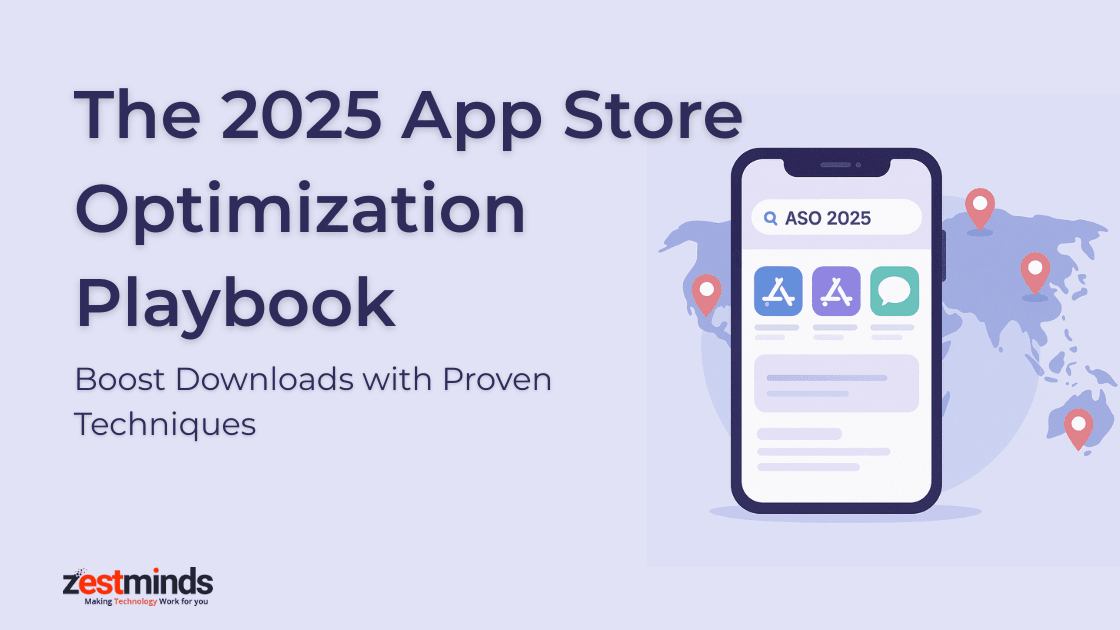The 2025 ASO Playbook: Boost Downloads with Proven Techniques
Get ahead in 2025: Boost app visibility, downloads, and retention with smart App Store Optimization strategies tailored for global markets.

Why ASO Matters in 2025
Imagine walking into a store where your product is on a hidden shelf, nobody will buy it because they can't see it. That's your app without App Store Optimization (ASO).
In 2025, ASO isn't optional. With over 7 million apps competing globally, ASO helps your app stand out, whether your audience is in New York, London, Sydney, or Berlin.
Key takeaway: ASO is not just about search rankings. It's about building trust, improving app quality, and converting page visitors into loyal users.
What is ASO? A Simple Breakdown
Think of ASO as SEO's cousin but for apps. It ensures your app appears when people search, and convinces them to click "install."
Key ranking factors:
- App title & subtitle (Apple) or short description (Google)
- Keywords relevance
- Visuals: screenshots, preview videos, icons
- User reviews and star ratings
- App update frequency and retention metrics
Example: An app named "Daily Budget – Expense Planner" ranks better than "DBudget" because it's descriptive and keyword-optimized.
Why ASO is Essential for Growth
82% of users find apps by searching in app stores (Source: SensorTower).
Without ASO, even a world-class app might go unnoticed. ASO drives organic discovery and builds trust before a download.
Mini case study: A health startup we worked with at Zestminds improved their install rate by 35% in Germany simply by localizing screenshots and rewriting their description in German cultural tone.
Mastering ASO Keyword Research
How to research keywords like a pro:
- Start with core terms like "expense tracker" or "budget planner."
- Use tools like AppTweak and Apple Search Ads for suggestions.
- Look at your competitors, what keywords are they ranking for?
- Think like your audience: Include conversational, voice-search-friendly phrases.
Example: Instead of "invoice app," a better keyword in 2025 might be "best invoicing app for freelancers."
Pro tip: If targeting multilingual markets, research keywords in each language, don't translate directly!
See how Zestminds helped an AI-powered event organizing and ticket booking app optimize keyword strategy.
Crafting Metadata That Converts
Optimizing App Titles & Subtitles
Shorter is better. Your app name and subtitle must tell a story in 60 characters or less.
Example: "CalmSleep – Sleep Sounds & Tracker" is clear and keyword-rich.
App Descriptions
- Use short paragraphs and bullets.
- Address pain points first ("Trouble sleeping?").
- Highlight key features quickly.
- Sprinkle relevant keywords naturally.
Did you know? Google indexes descriptions while Apple App Store doesn't, but a persuasive description still boosts conversions everywhere.
Visuals: Your Silent Salesperson
A polished icon and screenshots can lift conversions by up to 30% (Source: Moburst).
Checklist for visuals:
- Icons: Simple, readable at small sizes
- Screenshots: Add captions that show benefits
- Video preview: 15–30 seconds highlighting core experience
Example: A fitness app showing "1-click workout logging" as a caption below screenshots increases user confidence.
Trust cue: Show reviews, ratings, or media coverage badges in screenshots where allowed.
User Reviews & Ratings: The Trust Multiplier
Good reviews don't just happen, they're earned and encouraged.
- Ask users after a positive interaction (e.g., completing a task).
- Avoid asking too soon or too often.
- Monitor and respond to reviews to show you care.
Real-world example: A client's app doubled its rating from 3.5 to 4.5 stars by improving onboarding and asking for feedback after 7 days of usage.
Updates, Testing & Monitoring = ASO Success
You wouldn't leave your store dusty and outdated, your app page is the same.
- Update your app every 2–4 weeks (minor fixes count!)
- Test different screenshots and headlines (A/B testing)
- Monitor retention: Day 1, Day 7, Day 30 user activity matters
Mini-summary: Regular updates signal an active, quality product to both users and the app store algorithms.
Localization: The Fastest Route to Global Growth
Localize everything:
- Text (title, description, keywords)
- Screenshots (currency, language, cultural cues)
Example: An Australian campaign used Aussie spelling, slang, and referenced "dollar" instead of "pound" for UK users.
Fact: Apps localized for top global markets see 30%–50% more downloads (Source: AppTweak).
Advanced ASO 2025: The Future is Here
- Voice search optimization: Use conversational phrases.
- AI-driven keyword suggestions: Emerging tools predict seasonal keyword demand.
- Apple App Store in-app events: Promote events directly in your app listing.
External reference: Dogtown Media's ASO 2.0 Framework.
Conclusion: Ready to Win in 2025?
ASO is no longer optional, it's your growth engine.
Whether your goal is scaling in the US, expanding across Europe, or launching globally, the right ASO strategy can make or break your app's success.
Book a free ASO strategy session with Zestminds to get your custom 2025 ASO roadmap today!
FAQs
What's the #1 thing to improve ASO quickly?
Better visuals! App icons and screenshots are the fastest way to boost conversions.
How often should I localize?
Every major update. Localization isn't one-time, it evolves with your product.
Should I use paid ads or focus on ASO first?
Both help, but ASO builds a sustainable, long-term foundation for organic growth.
Is ASO worth it for small niche apps?
Yes, even niche audiences search the app store and expect quality presentation.

Shivam Sharma
About the Author
With over 13 years of experience in software development, I am the Founder, Director, and CTO of Zestminds, an IT agency specializing in custom software solutions, AI innovation, and digital transformation. I lead a team of skilled engineers, helping businesses streamline processes, optimize performance, and achieve growth through scalable web and mobile applications, AI integration, and automation.
Stay Ahead with Expert Insights & Trends
Explore industry trends, expert analysis, and actionable strategies to drive success in AI, software development, and digital transformation.


